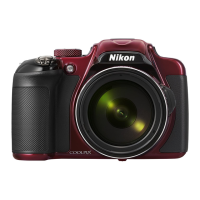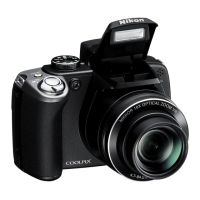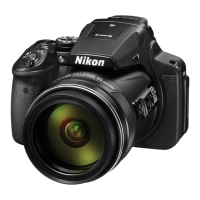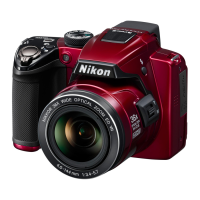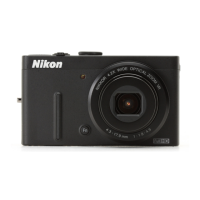Do you have a question about the Nikon CoolPix P60 and is the answer not in the manual?
Key precautions to prevent damage to the product or injury to users and others.
Information regarding FCC regulations for radio frequency interference.
Warning about lead exposure from product cords as required by California law.
Explanation of icons and notations used throughout the manual for clarity.
Details on storing pictures on internal memory or removable memory cards.
Emphasis on using only Nikon-certified accessories to prevent damage and voiding warranty.
Advice to take a test shot before important occasions to ensure normal camera function.
Information on manual reproduction, specification changes, and liability.
Legal notice regarding the prohibition of copying copyrighted materials.
Instructions for securely disposing of memory cards and internal camera memory.
Diagram and labeling of the camera's main body components and their functions.
Step-by-step visual guide for attaching the camera strap to the device.
Explanation of various icons and data displayed in the monitor during shooting.
Description of indicators displayed on the monitor during picture playback.
How to switch between monitor and electronic viewfinder displays and control info visibility.
Explanation of each shooting mode selection on the camera's mode dial.
Guide to using the multi selector for mode selection, menu navigation, and applying choices.
Instructions for displaying and navigating camera menus using the MENU button.
Detailed steps for inserting, replacing, and handling camera batteries safely.
Procedure for powering the camera on and off, including standby mode behavior.
Guide to selecting the language and configuring the camera's date and time settings.
Instructions for inserting, removing, formatting, and protecting memory cards.
Instructions for turning on the camera and selecting the Auto shooting mode.
Guidance on holding the camera, using the viewfinder, and operating the zoom.
How to focus on a subject and press the shutter-release button to capture an image.
Procedure for reviewing taken pictures and deleting unwanted ones in playback mode.
Description of different flash modes like Auto, Red-eye reduction, Fill flash, Slow sync.
Step-by-step guide to selecting and changing the camera's flash mode.
Explanation of the camera's advanced red-eye reduction feature.
Details on Autofocus, Infinity, and Macro close-up focus modes.
Procedure for choosing and applying the desired focus mode.
Steps for adjusting exposure compensation to make pictures brighter or darker.
Explanation of the exposure compensation guide and value settings.
How to select Portrait, Landscape, and Night Portrait modes using the mode dial.
Procedure for accessing and choosing from various scene modes via the camera menu.
Details on specific features and behaviors of Portrait and Landscape scene modes.
Using high sensitivity to reduce blur in low light or with subject movement.
Information on potential graininess, focus limitations, and available shooting options.
How to rotate the mode dial to P and adjust settings for creative intent.
Information regarding noise reduction and potential limitations on slow shutter speeds.
Steps to manually adjust shutter speed and aperture for exposure control.
Explanation of the EV display indicating over/underexposure during manual adjustments.
Information on noise reduction and shutter speed limitations when using M mode.
How to view multiple pictures simultaneously in a contact sheet format.
Instructions for zooming into pictures for closer inspection and navigating the zoomed view.
Overview of D-Lighting, Crop, and Small Picture editing features.
Limitations and compatibility notes for applying editing functions to pictures.
How to use D-Lighting to enhance brightness and contrast in pictures.
Steps to crop an image and create a new picture with the selected portion.
Guide to resizing pictures for web pages or email attachments.
Instructions for using the built-in microphone to record voice memos for pictures.
How to play back recorded voice memos and delete them from pictures.
Steps to start and end movie recording using the camera's built-in microphone.
Overview of available movie options, autofocus modes, and electronic VR settings.
Explanation of playback operations like rewind, advance, pause, and end.
Procedure for deleting movie files from the camera after playback.
Steps for connecting the camera to a TV using the supplied audio/video cable.
Ensuring the camera's video mode setting matches the television standard.
Instructions for installing Nikon Transfer and Panorama Maker software from the CD.
List of operating systems compatible with the COOLPIX P60 for software installation.
Recommendations for battery charge and AC adapter usage during computer connection.
Process flow for taking pictures and printing them directly via PictBridge.
Step-by-step guide for selecting and printing individual pictures directly from the camera.
Instructions for selecting multiple pictures and paper size for batch printing.
How to choose pictures and specify copy counts for DPOF print orders.
Options for including shooting date and photo data on printed images.
How to adjust image quality (compression) and image size (resolution) for pictures.
Details on image optimization options like contrast, sharpening, and saturation.
Explanation of white balance settings and how to adjust them for different lighting conditions.
Guide to adjusting camera sensitivity to light (ISO) for various shooting scenarios.
Description of different metering methods: Matrix, Center-weighted, Spot, Spot AF area.
Explanation of Single, Continuous, BSS, and Multi-shot 16 shooting modes.
How to select the focus area: Face priority, Auto, Manual, Center.
Choosing between Single AF and Full-time AF for focusing.
Adjusting flash output level relative to the background for optimal lighting.
Using D-Lighting for image enhancement and setting up pictures for printing.
Creating automatic slide shows and deleting selected or all pictures.
Protecting pictures from deletion and copying files between memory sources.
Customizing how menus are displayed and selecting the camera's welcome screen.
Setting the camera clock, time zones, and configuring monitor display options.
Options for imprinting date/time on pictures and enabling/disabling vibration reduction.
Configuring AF-assist illumination, digital zoom, and camera sound settings.
Setting auto power-off times and formatting internal memory or memory cards.
Solutions for issues related to blank monitors, display readability, and camera power.
Troubleshooting steps for when the camera fails to shoot or cannot focus properly.
Resolving problems with blurred pictures, flash errors, and digital zoom limitations.
Solutions for playback errors, picture display issues, and connectivity problems.
Details on camera type, sensor, lens, focal length, construction, and digital zoom.
Information on autofocus modes, focus range, focus area selection, and viewfinder coverage.
Details on monitor size/resolution and internal/external storage media.
Information on file system compliance and supported file formats for pictures and movies.
List of available image resolutions in pixels for recording pictures.
Details on the ISO sensitivity settings available for the camera.
Information on exposure control methods and the camera's shutter speed capabilities.
Details on flash control, data transfer protocols, and interface types.
List of languages supported for camera menus and messages.
Information on supported batteries and the AC adapter for powering the camera.
Approximate number of shots based on different battery types and shooting conditions.
Details on camera dimensions, weight, operating temperature, and humidity limits.
Explanation of standards like DCF, DPOF, Exif, and PictBridge supported by the camera.
Steps for taking camera out of box, inserting batteries, and turning on.
Guide to selecting language and setting date/time according to the initial setup dialog.
Visual instructions for securely attaching the camera strap to the device.
Guidance on framing subjects, checking indicators, and pressing the shutter button.
How to review images in playback mode and delete unwanted ones.
Details on the one-year limited warranty for defects in material and workmanship.
Conditions, limitations, and exclusions that apply to the Nikon product warranty.
Procedure for returning the product for repair or replacement under warranty.
Key precautions to prevent damage to the product or injury to users and others.
Information regarding FCC regulations for radio frequency interference.
Warning about lead exposure from product cords as required by California law.
Explanation of icons and notations used throughout the manual for clarity.
Details on storing pictures on internal memory or removable memory cards.
Emphasis on using only Nikon-certified accessories to prevent damage and voiding warranty.
Advice to take a test shot before important occasions to ensure normal camera function.
Information on manual reproduction, specification changes, and liability.
Legal notice regarding the prohibition of copying copyrighted materials.
Instructions for securely disposing of memory cards and internal camera memory.
Diagram and labeling of the camera's main body components and their functions.
Step-by-step visual guide for attaching the camera strap to the device.
Explanation of various icons and data displayed in the monitor during shooting.
Description of indicators displayed on the monitor during picture playback.
How to switch between monitor and electronic viewfinder displays and control info visibility.
Explanation of each shooting mode selection on the camera's mode dial.
Guide to using the multi selector for mode selection, menu navigation, and applying choices.
Instructions for displaying and navigating camera menus using the MENU button.
Detailed steps for inserting, replacing, and handling camera batteries safely.
Procedure for powering the camera on and off, including standby mode behavior.
Guide to selecting the language and configuring the camera's date and time settings.
Instructions for inserting, removing, formatting, and protecting memory cards.
Instructions for turning on the camera and selecting the Auto shooting mode.
Guidance on holding the camera, using the viewfinder, and operating the zoom.
How to focus on a subject and press the shutter-release button to capture an image.
Procedure for reviewing taken pictures and deleting unwanted ones in playback mode.
Description of different flash modes like Auto, Red-eye reduction, Fill flash, Slow sync.
Step-by-step guide to selecting and changing the camera's flash mode.
Explanation of the camera's advanced red-eye reduction feature.
Details on Autofocus, Infinity, and Macro close-up focus modes.
Procedure for choosing and applying the desired focus mode.
Steps for adjusting exposure compensation to make pictures brighter or darker.
Explanation of the exposure compensation guide and value settings.
How to select Portrait, Landscape, and Night Portrait modes using the mode dial.
Procedure for accessing and choosing from various scene modes via the camera menu.
Details on specific features and behaviors of Portrait and Landscape scene modes.
Using high sensitivity to reduce blur in low light or with subject movement.
Information on potential graininess, focus limitations, and available shooting options.
How to rotate the mode dial to P and adjust settings for creative intent.
Information regarding noise reduction and potential limitations on slow shutter speeds.
Steps to manually adjust shutter speed and aperture for exposure control.
Explanation of the EV display indicating over/underexposure during manual adjustments.
Information on noise reduction and shutter speed limitations when using M mode.
How to view multiple pictures simultaneously in a contact sheet format.
Instructions for zooming into pictures for closer inspection and navigating the zoomed view.
Overview of D-Lighting, Crop, and Small Picture editing features.
Limitations and compatibility notes for applying editing functions to pictures.
How to use D-Lighting to enhance brightness and contrast in pictures.
Steps to crop an image and create a new picture with the selected portion.
Guide to resizing pictures for web pages or email attachments.
Instructions for using the built-in microphone to record voice memos for pictures.
How to play back recorded voice memos and delete them from pictures.
Steps to start and end movie recording using the camera's built-in microphone.
Overview of available movie options, autofocus modes, and electronic VR settings.
Explanation of playback operations like rewind, advance, pause, and end.
Procedure for deleting movie files from the camera after playback.
Steps for connecting the camera to a TV using the supplied audio/video cable.
Ensuring the camera's video mode setting matches the television standard.
Instructions for installing Nikon Transfer and Panorama Maker software from the CD.
List of operating systems compatible with the COOLPIX P60 for software installation.
Recommendations for battery charge and AC adapter usage during computer connection.
Process flow for taking pictures and printing them directly via PictBridge.
Step-by-step guide for selecting and printing individual pictures directly from the camera.
Instructions for selecting multiple pictures and paper size for batch printing.
How to choose pictures and specify copy counts for DPOF print orders.
Options for including shooting date and photo data on printed images.
How to adjust image quality (compression) and image size (resolution) for pictures.
Details on image optimization options like contrast, sharpening, and saturation.
Explanation of white balance settings and how to adjust them for different lighting conditions.
Guide to adjusting camera sensitivity to light (ISO) for various shooting scenarios.
Description of different metering methods: Matrix, Center-weighted, Spot, Spot AF area.
Explanation of Single, Continuous, BSS, and Multi-shot 16 shooting modes.
How to select the focus area: Face priority, Auto, Manual, Center.
Choosing between Single AF and Full-time AF for focusing.
Adjusting flash output level relative to the background for optimal lighting.
Using D-Lighting for image enhancement and setting up pictures for printing.
Creating automatic slide shows and deleting selected or all pictures.
Protecting pictures from deletion and copying files between memory sources.
Customizing how menus are displayed and selecting the camera's welcome screen.
Setting the camera clock, time zones, and configuring monitor display options.
Options for imprinting date/time on pictures and enabling/disabling vibration reduction.
Configuring AF-assist illumination, digital zoom, and camera sound settings.
Setting auto power-off times and formatting internal memory or memory cards.
Solutions for issues related to blank monitors, display readability, and camera power.
Troubleshooting steps for when the camera fails to shoot or cannot focus properly.
Resolving problems with blurred pictures, flash errors, and digital zoom limitations.
Solutions for playback errors, picture display issues, and connectivity problems.
Details on camera type, sensor, lens, focal length, construction, and digital zoom.
Information on autofocus modes, focus range, focus area selection, and viewfinder coverage.
Details on monitor size/resolution and internal/external storage media.
Information on file system compliance and supported file formats for pictures and movies.
List of available image resolutions in pixels for recording pictures.
Details on the ISO sensitivity settings available for the camera.
Information on exposure control methods and the camera's shutter speed capabilities.
Details on flash control, data transfer protocols, and interface types.
List of languages supported for camera menus and messages.
Information on supported batteries and the AC adapter for powering the camera.
Approximate number of shots based on different battery types and shooting conditions.
Details on camera dimensions, weight, operating temperature, and humidity limits.
Explanation of standards like DCF, DPOF, Exif, and PictBridge supported by the camera.
Steps for taking camera out of box, inserting batteries, and turning on.
Guide to selecting language and setting date/time according to the initial setup dialog.
Visual instructions for securely attaching the camera strap to the device.
Guidance on framing subjects, checking indicators, and pressing the shutter button.
How to review images in playback mode and delete unwanted ones.
Details on the one-year limited warranty for defects in material and workmanship.
Conditions, limitations, and exclusions that apply to the Nikon product warranty.
Procedure for returning the product for repair or replacement under warranty.
| Megapixel | 8.1 MP |
|---|---|
| Sensor type | CCD |
| Maximum image resolution | 3264 x 2448 pixels |
| Optical zoom | 5 x |
| Focal length range | 6.4 - 32 mm |
| Number of diaphragm blades | 7 |
| Number of aspheric elements | 9 |
| Interface | UBS |
| Digital SLR | No |
| Built-in flash | Yes |
| Dimensions (WxDxH) | 95.5 x 36 x 63.5 mm |
| Effective sensor resolution | 8100000 pixels |
| Focal length (35mm film equivalent) | 36 - 180 mm |
| ISO sensitivity | 80, 100, 200, 400, 800, 1600, 2000, Auto |
| Memory slots | - |
| Internal memory | 12 MB |
| Compatible memory cards | sd |
| Video formats supported | AVI |
| Display diagonal | 12.5 \ |
| Product color | Black |
| Battery technology | Alkaline |
| Battery life (CIPA standard) | 190 shots |
| Number of batteries supported | 2 |
| Scene modes | beach, dusk, Fireworks, Museum, Night landscape, Night portrait, party (indoor), Portrait, Sports, Sunset, Landscape (scenery) |
| Image editing | Trimming |
| Photo effects | black&white, Vivid |
| White balance | auto, Cloudy, daylight, flash, Fluorescent, Incandescent |
| Camera playback | Slide show |
| Flash modes | auto, Flash off, Red-eye reduction, Slow synchronization |
| Depth | 36 mm |
|---|---|
| Width | 95.5 mm |
| Height | 63.5 mm |
| Weight | 160 g |
